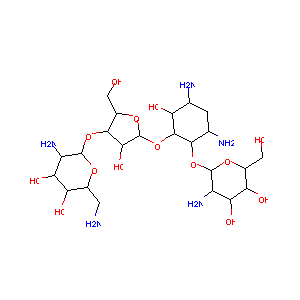Details of the Drug
General Information of Drug (ID: DM1AGXN)
| Drug Name |
Paromomycin
|
|||||||||||||||||||
|---|---|---|---|---|---|---|---|---|---|---|---|---|---|---|---|---|---|---|---|---|
| Synonyms |
Aminosidin; Catenulin; Humatin; Hydroxymycin sulfate; Paramomycin Sulfate; Paromomycin I; Paromomycin sulfate Rx346208; Aminosidine, sulfate; HATT & Paromomycin; Humatin (TN); Paromomycin (INN); Paromomycin (TN); Paromomycin (complex); PA1-PA2-PA3-PA4; Human .alpha.-1-antitrypsin & Paromomyin; PAROMOMYCIN I, AMMINOSIDIN, CATENULIN, CRESTOMYCIN, MONOMYCIN A, NEOMYCIN E; (1R,2R,3S,4R,6S)-4,6-diamino-2-{[3-O-(2,6-diamino-2,6-dideoxy-beta-L-idopyranosyl)-beta-D-ribofuranosyl]oxy}-3-hydroxycyclohexyl 2-amino-2-deoxy-alpha-D-glucopyranoside; (2S,3S,4R,5R,6R)-5-amino-2-(aminomethyl)-6-[(2R,3S,4R,5S)-5-[(1R,2R,3S,5R,6S)-3,5-diamino-2-[(2S,3R,4R,5S,6R)-3-amino-4,5-dihydroxy-6-(hydroxymethyl)oxan-2-yl]oxy-6-hydroxycyclohexyl]oxy-4-hydroxy-2-(hydroxymethyl)oxolan-3-yl]oxyoxane-3,4-diol; O-2-Amino-2-deoxy-.alpha.-D-glucopyranosyl-(1->4)-O-[O-2,6-diamino-2,6-dideoxy-.beta.-L-idopyranosyl-(1->3)-.beta.D-ribofuranosyl(1->5)]-2-deoxy-D-streptamine
|
|||||||||||||||||||
| Indication |
|
|||||||||||||||||||
| Therapeutic Class |
Antibiotics
|
|||||||||||||||||||
| Drug Type |
Small molecular drug
|
|||||||||||||||||||
| Structure |
 |
|||||||||||||||||||
| 3D MOL | 2D MOL | |||||||||||||||||||
| #Ro5 Violations (Lipinski): 4 | Molecular Weight (mw) | 615.6 | ||||||||||||||||||
| Topological Polar Surface Area (xlogp) | -8.7 | |||||||||||||||||||
| Rotatable Bond Count (rotbonds) | 9 | |||||||||||||||||||
| Hydrogen Bond Donor Count (hbonddonor) | 13 | |||||||||||||||||||
| Hydrogen Bond Acceptor Count (hbondacc) | 19 | |||||||||||||||||||
| ADMET Property |
|
|||||||||||||||||||
| Chemical Identifiers |
|
|||||||||||||||||||
| Cross-matching ID | ||||||||||||||||||||
Molecular Interaction Atlas of This Drug
 Drug Therapeutic Target (DTT) |
|
||||||||||||||||||||||||||
|---|---|---|---|---|---|---|---|---|---|---|---|---|---|---|---|---|---|---|---|---|---|---|---|---|---|---|---|
| Molecular Interaction Atlas (MIA) | |||||||||||||||||||||||||||
Drug-Drug Interaction (DDI) Information of This Drug
|
Coadministration of a Drug Treating the Disease Different from Paromomycin (Comorbidity)
|
|||||||||||||||||||||||||||||||||||
Drug Inactive Ingredient(s) (DIG) and Formulation(s) of This Drug
References
| 1 | FDA Approved Drug Products from FDA Official Website. 2009. Application Number: (ANDA) 064171. | ||||
|---|---|---|---|---|---|
| 2 | BDDCS predictions, self-correcting aspects of BDDCS assignments, BDDCS assignment corrections, and classification for more than 175 additional drugs | ||||
| 3 | Aminoglycoside association pathways with the 30S ribosomal subunit. J Phys Chem B. 2009 May 21;113(20):7322-30. | ||||
| 4 | 30S ribosomal subunit assembly is a target for inhibition by aminoglycosides in Escherichia coli. Antimicrob Agents Chemother. 2002 May;46(5):1546-9. | ||||
| 5 | The glycylcyclines: a comparative review with the tetracyclines. Drugs. 2004;64(1):63-88. | ||||
| 6 | Characterization of a 30S ribosomal subunit assembly intermediate found in Escherichia coli cells growing with neomycin or paromomycin. Arch Microbiol. 2008 May;189(5):441-9. | ||||
| 7 | Ribosomal resistance in the gentamicin producer organism Micromonospora purpurea. Antimicrob Agents Chemother. 1982 Aug;22(2):231-6. | ||||
| 8 | Bacterial resistance to aminoglycosides and beta-lactams: the Tn1331 transposon paradigm. Front Biosci. 2000 Jan 1;5:D20-9. | ||||
| 9 | Molecular dynamics simulations of the 30S ribosomal subunit reveal a preferred tetracycline binding site. J Am Chem Soc. 2008 Jan 30;130(4):1114-5. | ||||
| 10 | Functional insights from the structure of the 30S ribosomal subunit and its interactions with antibiotics. Nature. 2000 Sep 21;407(6802):340-8. | ||||
| 11 | Drugs, their targets and the nature and number of drug targets. Nat Rev Drug Discov. 2006 Oct;5(10):821-34. | ||||
| 12 | Reversed-phase high-performance liquid chromatography coupled to ultraviolet and electrospray time-of-flight mass spectrometry on-line detection fo... J Chromatogr A. 2008 Jun 27;1195(1-2):107-16. | ||||
| 13 | Detection of tetracycline resistance genes by PCR methods. Methods Mol Biol. 2004;268:3-13. | ||||
| 14 | Functional, biophysical, and structural bases for antibacterial activity of tigecycline. Antimicrob Agents Chemother. 2006 Jun;50(6):2156-66. | ||||
| 15 | Burkett L, Bikhazi GB, Thomas KC Jr, Rosenthal DA, Wirta MG, Foldes FF "Mutual potentiation of the neuromuscular effects of antibiotics and relaxants." Anesth Analg 58 (1979): 107-15. [PMID: 571233] | ||||
| 16 | FDA. U.S. Food and Drug Administration "FDA Drug Safety Communication: Low magnesium levels can be associated with long-term use of proton pump inhibitor drugs (PPIs).". | ||||
